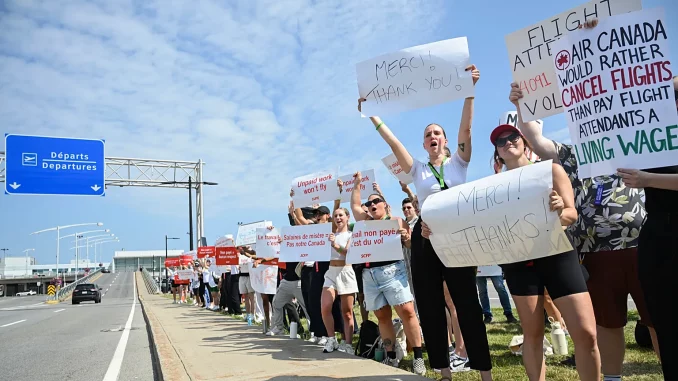
On August 17th, over 10,000 striking Air Canada workers took a historic step and continued their strike in defiance of a government order to return to work. In this extraordinary moment, workers forced Air Canada back to the bargaining table, and a tentative agreement was reached.
After workers’ existing union contract expired in March, labor negotiations had been ongoing but reached an impasse in August, when 99.7% of workers voted in favor of the strike. The conflict centered on workers’ simple demands to be paid for all their hours worked, and for a pay raise to address the increased cost of living. Under the existing pay structure, Air Canada flight attendants were only paid while they were in the air, meaning all work performed while the plane was on the ground was free labor. Hours of time spent in pre-flight safety checks, assistance with boarding, and waiting in airports for flight delays were not accounted for in workers’ paychecks. According to the Canadian Union of Public Employees, the union representing the striking workers, flight attendants performed about 35 hours (or almost a whole workweek) of unpaid labor every month.
Even for the hours that they were paid, flight attendants’ wages were not keeping up with the cost of living. Air Canada’s initial proposal for a new contract would have still kept full-time junior flight attendants earning less than minimum wage. According to union reports, flight attendants in Vancouver were living in their cars and union offices had to open food banks to support struggling workers.
These offers of poverty wages come at a time when airlines are reporting billions of dollars in record profits as the industry has rebounded from the COVID pandemic.
Despite these inexcusable labor practices, the government jobs minister declared the strike too disruptive to “industrial peace” and ordered the workers off the picket line and back to work. Although the strike did disrupt the travel plans of many people, polling showed that the majority of Canadians supported the striking workers.
In a remarkable demonstration of solidarity and worker power, the striking Air Canada workers refused to return to work, risking fines, termination of employment, and even jail time. Their resolve forced contract negotiations to continue and a tentative agreement to be drawn up.
Unfortunately, initial reports on the content of the tentative agreement revealed that union officials did not bring the same fortitude to the bargaining table that was displayed by the rank-and-file workers. The tentative agreement is still pending a worker vote, and some workers have expressed disappointment in proposals for wage increases and pay structures for different types of labor.
However, this tentative agreement does not take away from the impressive strength shown by Air Canada workers. Their solidarity proved that even the government is no match for the collective power of workers, when they are organized and committed to their cause. Their strike has also caused shockwaves throughout the United States airline industry, where U.S. flight attendants are now discussing how they too can be fairly compensated for labor performed on the ground. Although the struggle continues, the courage and commitment of Air Canada workers is an inspiration to workers everywhere.

